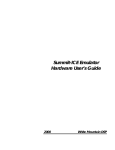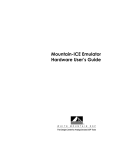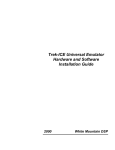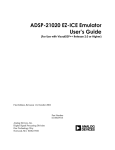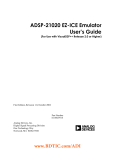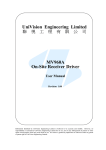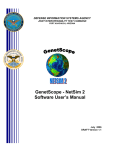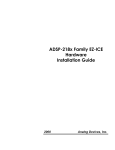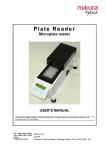Download Apex-ICE USB Emulator Hardware Installation Guide
Transcript
Apex-ICE USB Emulator Hardware Installation Guide Notice Analog Devices reserves the right to make changes to or to discontinue any product or service identified in this publication without notice. Analog Devices assumes no liability for Analog Devices applications assistance, customer product design, customer software performance, or infringement of patents or services described herein. In addition, Analog Devices shall not be held liable for special, collateral, incidental or consequential damages in connection with or arising out of the furnishing, performance, or use of this product. Analog Devices products are not intended for use in life-support applications, devices, or systems. Use of an Analog Devices product in such applications without the written consent of the Analog Devices officer is prohibited. Users are restricted from copying, modifying, distributing, reverse engineering, and reverse assembling or reverse compiling the Apex-ICE operational software (one copy may be made for back-up purposes only). No part of this document may be reproduced in any form without permission. Trademarks are property of their respective holders. Limited Warranty The Apex-ICE hardware is warranted against defects in materials and workmanship for a period of one year from the date of purchase from Analog Devices or from an authorized dealer. Copyright © 1999-2000, Analog Devices, Inc. All rights reserved. Revision 1.2, January 2000 MANAPEXICE i Contents 1. INTRODUCTION ......................................................................................1 2. REQUIREMENTS .....................................................................................2 3. CONFIGURATION AND INSTALLATION ..........................................3 3.1 3.2 3.3 3.5 3.6 INSTALLATION..................................................................................................... 3 HARDWARE AND WINDOWS 98 DRIVER INSTALLATION........................... 4 HARDWARE CONFIGURATION (WINDOWS 98) ............................................. 8 SOFTWARE INSTALLATION AND OPERATION............................................ 10 CONFIGURING THE APEX-ICE POD................................................................ 10 3.6.1 REDUCING NOISE ISSUES ASSOCIATED WITH JTAG SIGNALS ...... 11 3.8 CONNECTING THE POD TO YOUR TARGET SYSTEM................................. 12 4. INITIALIZING THE APEX-ICE............................................................14 4.1 DOWNLOADING SERVER SOFTWARE TO THE APEX-ICE .......................... 15 5. SUPPORT....................................................................................................16 5.1 TECHNICAL SUPPORT....................................................................................... 16 5.2 QUALITY ASSURANCE...................................................................................... 16 ii 6. REFERENCES ..............................................................................17 List of Figures FIGURE 1. FIGURE 2. FIGURE 3. FIGURE 4. FIGURE 5. FIGURE 6. FIGURE 7. FIGURE 8. FIGURE 9. ADD NEW HARDWARE WIZARD ...................................................4 ADD NEW HARDWARE WIZARD ...................................................5 ADD NEW HARDWARE WIZARD ...................................................6 ADD NEW HARDWARE WIZARD ...................................................7 ADD NEW HARDWARE WIZARD ...................................................8 THE DEVICE MANAGER ................................................................9 THE APEX-ICE PROPERTIES PAGE .............................................10 JUMPERS.....................................................................................11 TERMINATORS CONNECTED TO THE JTAG SIGNALS .................12 iii 1. Introduction Thank you for purchasing the Apex-ICE™ USB emulation system. The White Mountain DSP Apex-ICE Universal Serial Bus Emulator system provides state-of-the-art emulation and support for the Analog Devices JTAG Family of DSPs. It provides a controlled environment for observing, debugging, and testing activities in a target system by connecting directly to the target processor through the JTAG interface. Features of the Apex-ICE system are as follows: s Plug-n-Play USB product s Runs only under Windows®98 s Emulation for the industry standard Analog Devices JTAG Family of DSPs s Rugged high-speed JTAG emulation pod s Multi processor support 1 2. Requirements The minimum PC host requirements for the Apex-ICE are as follows: s Pentium 166 MHz or better s Minimum of 32 megabytes of RAM memory s Windows 98 operating system s One Full Speed USB port 2 3. Configuration and Installation This section provides all of the information required to install the Apex-ICE USB Emulator into your PC. To install the emulator software please refer to the Apex-ICE Emulator Software User’s Guide. 3.1 Installation For specific instructions on installing a USB device into your computer consult the documentation that is provided by the manufacturer of your computer. In general you should be able to use the following instructions. F Important! The Apex-ICE, Analog Devices JTAG Family of DSPs emulator contains ESD (electrostatic discharge) sensitive devices. Electrostatic charges readily accumulate on the human body and equipment and can discharge without detection. Permanent damage may occur to devices subjected to high-energy discharges. Proper ESD precautions are recommended to avoid performance degradation or loss of functionality. 3 3.2 Hardware and Windows 98 Driver Installation The Apex-ICE requires one USB port. Configuration of the board is performed automatically at boot up due to plug-n-play hardware support. Prior to using your Apex-ICE for the first time the Windows 98 Driver must first be installed. This is accomplished as follows: 1. Connect the Apex-ICE to a full speed USB port on the back of the computer. 2. Power on the PC and start Windows 98. This will activate the Windows 98 “Add New Hardware Wizard” as shown in figure 1. Click Next. Figure 1. Add New Hardware Wizard 4 3. Select Search for the best driver for your device as shown in figure 2. Click Next. Figure 2. Add New Hardware Wizard 4. Insert the disk labeled “White Mountain DSP Driver Disk for Windows 95/98” into the floppy drive and click next. Windows 98 will then automatically detect and install the Apex-ICE driver from the disk as shown in figure 3. Click Next 5 Figure 3. Add New Hardware Wizard 5. The Add New Hardware Wizard will locate the ApexICE.inf file on the floppy as shown in figure 4. Click Next 6 Figure 4. Add New Hardware Wizard 6. Click Finish and the driver installation is completed as shown in figure 5. Click Next 7 Figure 5. Add New Hardware Wizard 3.3 Hardware Configuration (Windows 98) To ensure proper installation with use of the Device Manager in Windows 98 do the following: 1. Click on the “Start” button. 2. Select “Settings” then “Control Panel.” 3. Double click the “System” icon. 4. Select the “Device Manager” tab. 5. Double click “DSP Emulators”. A window similar to that shown in figure 6 should be displayed. 8 Figure 6. The Device Manager 6. Double click “Apex-ICE USB Emulator” This will display the Apex-ICE Properties page as shown in figure 7. The status of the Apex-ICE will be shown in the window. The device status should report that the device is working properly. 9 Figure 7. The Apex-ICE Properties Page 3.5 Software Installation and Operation To install and operate the debugger software, refer to the Software User’s Guide included with the software distribution. 3.6 Configuring the Apex-ICE Pod The Apex-ICE pod contains two internal jumpers for reducing noise issues associated with JTAG signals. These jumpers are accessible by removing the four screws on the bottom of the plastic enclosure and removing the top of the enclosure. The jumpers are shown in figure 8. 10 Figure 8. Jumpers 3.6.1 Reducing Noise Issues Associated With JTAG Signals There are two jumpers provided to help reduce problems that may arise because of ringing and reflections on the JTAG signals on the target board. The default settings for these jumpers are not installed. The two jumpers are JP1 and JP2. Jumpers JP1 and JP2 are used for adding a parallel terminator on the TDO and CLKIN signals. When the jumpers are installed a parallel terminator of 120Ω and 91Ω is connected to the TDO and CLKIN signals. Figure 9 shows how the terminators are connected to the JTAG signals. It is important to note that the target MUST be able to drive a 51Ω load before these jumpers are installed. The DSP cannot drive this load directly, a driver should be inserted between the JTAG signals at the DSP and the JTAG signals at the header. 11 Figure 9. Terminators Connected To The JTAG Signals 3.8 Connecting the Pod to Your Target System The pod connects to the target processor via the JTAG header. The target board must be built with an appropriate JTAG header, which is shown in figure 10. Please note the position of the key pin. The key pin should be used as a guide to connect the pod to the target. Included with the Apex ICE system are two extender connectors. These extenders are used to connect the Apex-ICE system to a target, which was designed for use with the Analog Devices ICEPAC ™. These extenders allow connection to the JTAG pins on the ICEPAC header. 12 Figure 10. Target Board JTAG Connector 13 4. Initializing the Apex-ICE The Apex-ICE is shipped from the factory with a generic boot loader application written into boot FLASH memory. No specific ICE application software is shipped with the hardware, and must be remotely downloaded from the Host via a special utility (Apexinit.exe). When the Apex-ICE is powered on or reset, the generic boot loader performs all of the necessary system initialization, runs the ICE application software if a valid program resides in flash, from a previous load or waits for the host to download the Apex-ICE application software via USB. From the host, the Apexinit.exe “client” utility is invoked to communicate with the Apex-ICE hardware remotely over USB. The four options for apexinit are described below. Consult your manufactures DSP tools software manuals for detailed information on Host configuration and operation with Apex-ICE. 14 4.1 Downloading Server Software to the Apex-ICE The apexinit utility only works with a single Apex-ICE at a time. The apexinit utility takes four arguments. When downloading a server application the –f option is used followed by the name of the image to download. When resetting the Apex-ICE the –r option is used. When clearing the flag the –c option is used. This option must be performed before the server application program can be downloaded. When inquiring about version information the –v option is used. Some examples using the DOS prompt follow: C:\Apex-ICE\apexinit –f apexxxxx.hex C:\Apex-ICE\apexinit –r C:\Apex-ICE\apexinit –c C:\Apex-ICE\apexinit –v 15 5. Support 5.1 Technical Support We fully support all of our products. For technical support of the Apex-ICE, call (603) 883-2430 Monday - Friday during normal business hours or via e-mail at [email protected]. For direct support of the Analog Devices SHARC family of DSPs, call the Analog Devices’ DSP Applications Engineering group at (781) 461-3672. 5.2 Quality Assurance White Mountain DSP, Inc. is committed to providing quality products and services. In efforts to continually provide this quality, please contact our Quality Assurance Department directly if you have any concerns at (603) 883-2430 Monday-Friday during normal business hours or via e-mail at [email protected]. Our Quality Assurance Manager will listen to your concerns and provide a timely and effective solution. 16 6. References This section discusses other documentation resources you will need to develop your application. • For information on the architecture and system interface of the ADSP processor, refer to the appropriate Analog Devices JTAG Family of DSPs User’s Manual. • For ADSP timing specification and other hardware design information, refer to the appropriate Analog Devices JTAG Family of DSPs Data Sheet. • For complete information on software development tools (Assembler, Linker, PROM Splitter, Assembly Library, and Simulator), refer to the following documents: ADSP-21000 Family Development Software/ ADSP-21000 Family C Tools Release 3.1 Release Note ADSP-21000 Family Assembler Tools & Simulator Manual ADSP-21000 Family C Runtime Library Manual ADSP-21000 Family C Tools Manual • For information about your development platform, refer to your operating system manuals and hardware system manuals. 17 • For information about digital signal processing theory and applications, you may which to consult: Higgins. Digital Signal Processing In VLSI. Prentice-Hall, 1990. Oppenheim and Schafer. Digital Signal Processing. Prentice-Hall, 1975. • For information on the emulator software, refer to the Software Users Guide. • For information on designing the interface between an Analog Devices SHARC DSP and the emulation header on your custom DSP target board, refer to White Mountain DSP’s Inside Edge Application note 98-1. 18






















